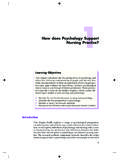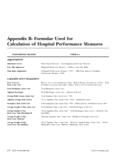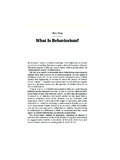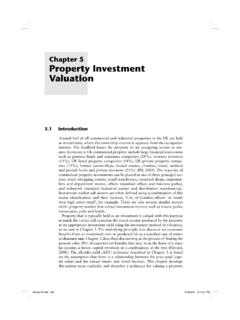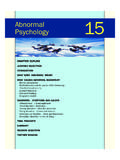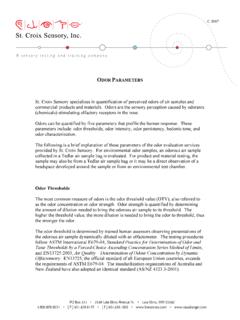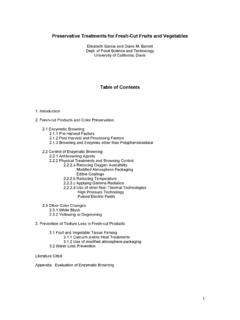Transcription of Ascending Sensory Pathways
1 A variety of Sensory receptorsscattered throughout the bodycan become activated by exteroceptive, interoceptive, or proprioceptive input. Exteroceptive input relays sensoryinformation about the body s interaction with the externalenvironment. Interoceptive input relays information aboutthe body s internal state, whereas proprioceptive input con-veys information about position sense from the body and its component parts. Each receptor is specialized to detectmechanical, chemical, nociceptive (L.)
2 Nocere, to injure, painful ), or thermal stimuli. Activation of a Sensory recep-tor is converted into nerve impulses and this Sensory input isthen conveyed via the fibers of the cranial or spinal nerves totheir respective relay nuclei in the central nervous system(CNS). The Sensory information is then further processed as itprogresses, via the Ascending Sensory systems ( Pathways ),to the cerebral cortex or to the cerebellum. Sensory informa-tion is also relayed to other parts of the CNS where it mayfunction to elicit a reflex response, or may be integrated intopattern-generating Ascending Sensory Pathways are classified accordingto the functional components (modalities) they carry as wellas by their anatomical localization.
3 The two functional categor-ies are the general somatic afferent (GSA) system, whichtransmits Sensory information such as touch, pressure, vibra-tion, pain, temperature, stretch, and position sense fromsomaticstructures; and the general visceral afferent (GVA)system, which transmits Sensory information such as pressure,pain, and other visceral sensation from visceralstructures. A 60-year-old woman com-plains of falls, imbalance, andnumbness and tingling in her hands andlegs.
4 There is also some incoordination ofhand use and she has difficulty manipu-lating small items such as buttons. She isunable to play the piano now since shecannot position her fingers correctly onthe piano keys. She thinks the strength inher arms and legs is adequate. Symptomsstarted with very slight tingling sensa-tions, which she noticed about 5 yearsago. The falls and difficulty walking havebeen present for about 2 months. Higherorder cognitive functions are intactaccording to her husband. Her vision examination, the patient showsnormal mental status.
5 Strength seemsessentially normal throughout. Sensation,particularly to vibration and joint posi-tion, is severely diminished in the distalupper and lower limbs (arms, legs, hands,and feet). Tendon reflexes are normal inthe arms, but somewhat brisk in the legsat the knees and ankles. Gait is moder-ately ataxic and she has to reach out forsupport by touching the walls of the hallway at times. Fine movements of the fingers are performed poorly, eventhough finger and wrist strength CASECHAPTER 10 Ascending Sensory PathwaysCLINICAL CASESENSORY RECEPTORSANTEROLATERAL SYSTEMTACTILE SENSATION ANDPROPRIOCEPTIONSENSORY Pathways TO THECEREBELLUMCLINICAL CONSIDERATIONSMODULATION OF NOCICEPTIONNEUROPLASTICITYSYNONYMS AND EPONYMSFOLLOW-UP TO CLINICAL CASEQUESTIONS TO PONDERATOC10 3/17/06 10.
6 06 AM Page 137 Anatomically, the Ascending Sensory systems consist of three distinct Pathways : the anterolateral system (ALS), thedorsal column medial lemniscal (DCML) pathway , and thesomatosensory Pathways to the anterolateral system, which includes the spinothala-mic, spinoreticular, spinomesencephalic,spinotectal, andspinohypothalamic tracts, relays predominantly pain andtemperature sensation, as well as nondiscriminative (crudeor poorly localized) touch, pressure, and some propriocep-tive sensation (Table ).
7 The dorsal column medial lemniscal pathway (whichincludes the fasciculus gracilis, fasciculus cuneatus, andmedial lemniscus) relays discriminative (fine) tactile sense,vibratory sense, and position sense (Table ).The somatosensory Pathways to the cerebellum, whichinclude the anterior, posterior, and rostral spinocerebellar,as well as the cuneocerebellar tracts, relay primarily propri-oceptive (but also some pain and pressure) information (Table ).The Ascending Sensory Pathways are the main avenues bywhich information concerning the body s interaction with theexternal environment, its internal condition, and the positionand movement of its parts, reach the brain.
8 One similarityshared by all three Ascending Sensory Pathways from thebody (not including the head or face) is that the first orderneuron cell bodies reside in the dorsal root ganglia. It is interesting to note that conscious perceptionof sensoryinformation from external stimuli is mediated by thespinothalamicand DCML pathwaysto the ventral posteriorlateral nucleus of the thalamus, whereas sensations that donotreach consciousness are mediated by the spinoreticular,spinomesencephalic,spinot ectal, spinohypothalamic, andthe anterior, posterior, androstral spinocerebellar, andcuneocerebellar tracts.
9 These tracts terminate in the reticularformation, mesencephalon, hypothalamus and cerebellum, input may ultimately elicit a reflex or other motor response because of the functional integration of theascending (somatosensory) Pathways , the cerebellum, andthe somatosensory cortex, as well as the motor cortex anddescending (motor) Pathways . Furthermore, descendingprojections from the somatosensory cortex, as well as fromthe raphe nucleus magnusand the dorsolateral pontinereticular formationto the somatosensory relay nucleiof thebrainstem and spinal cord, modulate the transmission ofincoming Sensory impulses to higher brain chapter includes a description of the Sensory recep-tors and the Ascending Sensory Pathways from the body,whereas the Ascending Sensory Pathways from the head.
10 Transmitted mostly by the trigeminal system, are described in Chapter RECEPTORSA lthough Sensory receptorsvary according to their mor-phology, the velocity of con-duction, and the modality towhich they respond, as well as to their location in the body,they generally all function in a similar fashion. The stimulusto which a specific receptor responds causes an alteration inthe ionic permeability of the nerve endings, generating areceptor potentialthat results in the formation of actionpotentials.




